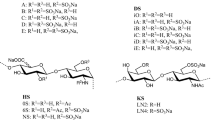Abstract
Six-weeks-old Wistar rats were injected intraperitoneally with sodium [35S]sulphate. The animals were sacrificed after 1 h and the molar teeth were extracted. The pulp and dentine were isolated by differential flotation and examined for glycosaminoglycans following decalcification and proteolysis. Examination of the product by cellulose acetate electrophoresis revealed the presence of a single metachromatic component which was radioactive. Chemical analysis, infrared spectroscopy and enzymic susceptibility identified the product as chondroitin 4′ sulphate. The results provide direct chemical evidence that sodium [35S]sulphate is rapidly incorporated into the sulphated glycosaminoglycans of the organic matrix of the rat molar tooth and that this tissue is a useful model for investigating the metabolism of the connective tissue ground substance.
Résumé
Des rats Wistar, âgés de six semaines, sont injectés par voie intrapéritonéale avec du (35S) sulfate de sodium. Les animaux sont sacrifiés après 1 h et les molaires sont extraites. La pulpe et le dentine sont isolées par flottation différencielle et les glycosaminoglycanes sont étudiés après décalcification et protéolyse. L'étude du produit par électrophorèse sur acétate de cellulose montre la présence d'un composant métachromatique simple qui est radioactif. Des analyses chimiques, la spectroscopie infra-rouge et la réactivité aux enzymes permettent d'identifier le produit comme du sulfate 4′ chondroitine. Les résultats apportent une preuve chimique directe de l'incorporation rapide du (35S) sulfate de sodium dans les glycosaminoglycanes sulfatés de la matrice organique de molaires de rats. Ce tissu est un modèle intéressant pour l'étude du métabolisme de la substance fondamentale du tissu conjonctif.
Zusammenfassung
Sechs Wochen alte Wistar-Ratten erhielten Natrium-[35S]-Sulfat intraperitoneal. Die Tiere wurden 1 Std nach der Injektion getötet, und ihre Backenzähne wurden extrahiert. Pulpa und Dentin wurden mittels der Differential-Flotation isoliert und auf Glycosaminoglycane nach Entkalkung und Proteolyse untersucht. Die Prüfung des Produktes mittels Zellulose-Acetat-Elektrophorese zeigte die Anwesenheit einer einzigen metachromatischen Komponente, welche radioaktiv war. Chemische Analyse, Infrarot-Spektroskopie und enzymatische Spaltbarkeit erlaubten die Identifikation des Produktes als Chondroitin-4′-Sulfat. Die Resultate liefern den direkten chemischen Beweis, daß Natrium-[35S]-Sulfat rasch in die sulfatierten Glycosaminoglycane der organischen Matrix der Ratten-Backenzähne eingebaut wird und daß dieses Gewebe ein nützliches Modell ist, um den Stoffwechsel der Grundsubstanz des Bindegewebes zu untersuchen.
Similar content being viewed by others
References
Battistone, G. C., Burnett, G. W.: Studies of the composition of teeth. III. The amino acid composition of human dentinal protein. J. dent. Res.35, 255–259 (1956)
Bitter, T., Muir, H. M.: A modified uronic acid carbazole reaction. Analyt. Biochem.4, 330–334 (1962)
Campo, R. D., Dziewiatkowski, D. D.: Intracellular synthesis of protein-polysaccharides by slices of bovine costal cartilage. J. biol. Chem.237, 2729–2735 (1962)
Clark, R. D., Smith, J. G., Davidson, E. A.: Hexosamine and acid glycosaminoglycans in human teeth. Biochim. biophys. Acta (Amst.)101, 367–372 (1965)
Dodgson, K. S., Lloyd, A. G.: In: Carbohydrate metabolism and its disorders, vol. 1, p. 169, eds. Dickens, F., Randle, P. J., Whelan, W. J. New York: Acad. Press 1968
Dodgson, K. S., Price, R. G.: A note on the determination of the ester sulphate content of sulphated polysaccharides. Biochem. J.84, 106–110 (1962)
Elson, L. A., Morgan, W. T. J.: A colourimetric method for the determination of glucosamine and chondrosine. Biochem. J.27, 1824–1828 (1933)
Embery, G.: (1973) Unpublished work
Engfeldt, B., Hjerpe, A.: Glycosaminoglycans of dentine and predentine. Calcif. Tiss. Res.10, 152–159 (1972)
Fransson, L. A., Anseth, A.: Studies on corneal polysaccharides: Part IV. Chromatography of corneal glycosaminoglycans on Ecteola Cellulose using formate buffers as eluting solvents. Exp. Eye Res.6, 107–119 (1967)
Hardingham, T., Muir, H. M.: Biosynthesis of glycosaminoglycans in cartilage slices. Fractionation by gel-chromatography and equilibrium density gradient centrifugation. Biochem. J.126, 791–803 (1972)
Iverius, P.-H.: Coupling of glycosaminoglycans to agarose beads (Sepharose 4B). Biochem. J.124, 677–683 (1971)
Kennedy, J. S., Kennedy, G. D. C.: Sulphated mucopolysaccharides in rodent teeth. J. Anat. (Lond.)91, 398–408 (1957)
Lennox, D. W., Provenza, D. V.: Mucopolysaccharides in odontogenesis. Histochem.23, 328–341 (1970)
Linde, A.: Glycosaminoglycans (mucopolysaccharides) of the porcine dental pulp. Arch. oral Biol.15, 1035–1046 (1970)
Linde, A.: (1972) Unpublished work
Lloyd, A. G., Dodgson, K. S., Price, R. G., Rose, F. A.: Infrared studies on sulphate esters. I. Polysaccharide sulphates. Biochim. biophys. Acta (Amst.)46, 108–115 (1961)
Meyer, K., Davidson, E., Linker, A., Hoffman, P.: The acid mucopolysaccharides of connective tissue. Biochim. biophys. Acta (Amst.)21, 506–518 (1956)
Orr, S. F. D.: Infrared spectroscopic studies of some polysaccharides. Biochim. biophys. Acta (Amst.)14, 173–181 (1954)
Orr, S. F. D., Harris, R. J. C., Sylvén, B.: Evidence from infrared spectroscopy for the composition of certain polysaccharides. Biochim. biophys. Acta (Amst.)14, 173–181 (1954)
Sundstrom, B.: New aspects on the utilisation of inorganic sulphate during dentin formation. Histochem.26, 61–66 (1971)
Swann, D. A., Balazs, E. A.: Determination of hexosamine content of macromolecules with manual and automated techniques using the p-dimethylaminobenzaldehyde seaction. Biochim. biophys. Acta (Amst.)130, 112–129 (1968)
Tsiganos, C. P., Muir, H. M.: The natural heterogeneity of proteoglycans of porcine and human cartilage. In: Chemistry and molecular biology of the intercellular matrix, vol. 2, p. 859–866, ed. Balazs, E. A. London: Academic Press 1970
Warren, L.: The thiobarbituric acid and assay of sialic acids. J. biol. Chem.234, 1971–1975 (1959)
Yamagata, T., Saito, H., Habuchi, O., Suzuki, S.: The purification and properties of bacterial chondroitinase and chondrosulphatases. J. biol. Chem.234, 1523–1535 (1968)
Author information
Authors and Affiliations
Rights and permissions
About this article
Cite this article
Embery, G. The isolation of chondroitin 4-[35S]sulphate from the molar teeth of young rats receiving sodium[35S]sulphate. Calc. Tis Res. 14, 59–65 (1974). https://doi.org/10.1007/BF02060283
Received:
Accepted:
Issue Date:
DOI: https://doi.org/10.1007/BF02060283




